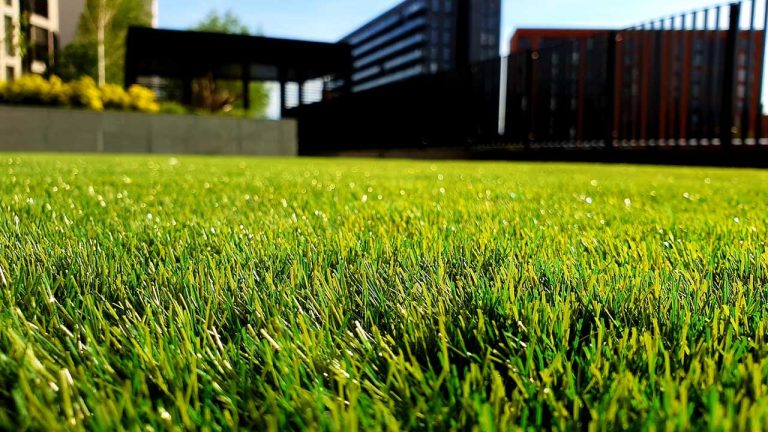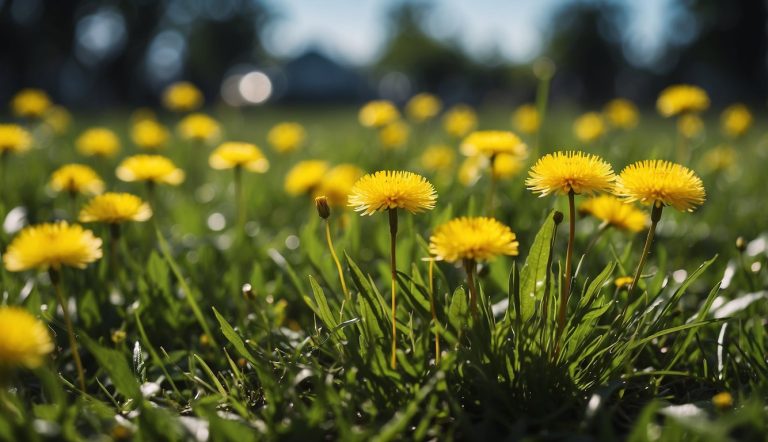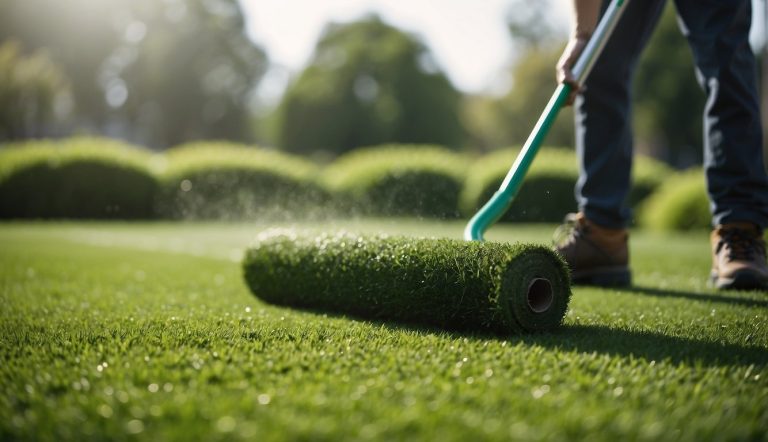Is Lawn Aeration Necessary? Unveiling the Truth Behind Lush Lawns
Lawn aeration is a vital process in maintaining a healthy and vibrant garden, involving the perforation of the soil to allow air, water, and nutrients to penetrate the grass roots. This process helps the roots grow deeply and produce a stronger, more vigorous lawn.
The necessity of lawn aeration is often identified by the presence of compacted soil or thatch—a layer of dead and living grass shoots, stems, and roots that can accumulate on the surface of the lawn.
A thick layer of thatch can prevent moisture, oxygen, and nutrients from reaching the soil effectively, hindering the growth and health of the grass.

Timing plays a crucial role in the success of lawn aeration. Typically, the best times to aerate a lawn are during the growing season when the grass can heal and fill in any open areas after the soil plugs are removed. This season usually falls in the early spring or fall for cool-season grasses, and late spring through early summer for warm-season varieties.
Aeration can involve various techniques and tools, from manual aerators to more sophisticated machinery. After aeration, steps should be taken to ensure the lawn continues to benefit from the process, such as watering appropriately and considering overseeding if it’s needed to encourage dense growth.
Key Points…
- Lawn aeration promotes deeper root growth and a healthier lawn.
- The right timing for aeration is critical, generally during the grass’s growing season.
- After aeration, maintain the lawn with proper care, including watering and possibly overseeding.
What is Lawn Aeration?
Before we dive into what aeration actually is and why it’s beneficial, it’s essential for me to clarify that a well-aerated lawn can be the key to a healthy and vibrant grass.
What Is Aeration?
Aeration is the process of creating holes in the lawn to allow air, water, and nutrients to penetrate the soil. This is particularly important when I’ve got compact soil, as it helps to improve the soil structure and allows grass roots to breathe and grow more deeply, creating a stronger, more robust lawn.
There are a few methods to aerate your lawn, but the most effective ones involve removing small plugs of soil to ensure that the compact layer is disrupted.
Benefits of Aeration
I’ve found that aerating my lawn offers a multitude of benefits:
- Improved Air Exchange: This allows oxygen to reach the grass roots and carbon dioxide to escape, which is crucial for robust root growth and the overall health of my lawn.
- Enhanced Soil Water Uptake: After I aerate my lawn, I notice that water penetrates the soil more easily, reducing runoff and helping my grass stay hydrated.
- Stronger Root System: By reducing soil compaction, the roots can expand more significantly, leading to a healthier and sturdier lawn.
- Better Nutrient Absorption: Aeration helps nutrients reach the root zone where my grass can use them more effectively.
- Thatch Breakdown: It can also help in breaking down thatch, which if left unchecked, can prevent nutrients, water, and air from reaching the soil.
By regularly aerating my lawn, I help ensure that the necessary elements for a healthy lawn, such as oxygen, water, and nutrients, can reach the soil and consequently, the grass roots. This not only improves the vigor and durability of my lawn but also enhances its ability to withstand various stresses, such as drought and foot traffic.
When is the Best Time for Lawn Aeration?
I find it’s crucial to time aeration correctly to ensure the healthiest lawn possible. Here’s what I’ve learned about the optimal timing for this task:
Optimal Aeration Seasons
For cool-season grasses, such as Kentucky bluegrass or ryegrass, the best times to aerate are either in the early spring or in the early fall. This is when the grasses are growing most vigorously, and the soil temperatures are ideal for grass recovery and growth.
Warm-season grasses, on the other hand, tend to benefit most from aeration during late spring to early summer. This season aligns with their peak growth period, allowing the lawn to heal quickly from the aeration process.
Here’s a quick guide to help you remember:
- Early Spring: Good for cool-season grass as they start their growth spurt.
- Late Spring to Early Summer: Ideal for warm-season grass to thrive post-aeration.
- Early Fall: Another chance to aerate cool-season grasses, making the most of favorable soil temperatures and minimal weed competition.
Remember, aeration is most effective when the soil is moist but not saturated, as it allows the aeration equipment to penetrate the soil more easily and create the necessary space for air, nutrients, and water to reach the roots of your lawn.
Aeration Techniques and Tools
In my experience with lawn care, choosing the right aeration technique and tool can significantly impact the health of a lawn. Aeration combats compaction and promotes root growth by allowing air, water, and nutrients to penetrate the soil.
Core Aeration
The core aeration method involves using a core aerator, sometimes called a plug aerator. This equipment extracts small plugs of soil and thatch from the lawn to relieve compaction. Core aerators often have hollow tines that create open channels for nutrients and water to enter the soil. Core aeration is generally the most effective method, especially for lawns with heavy compaction or clay soils.
- Tool Options:
- Manual Core Aerators: best for small areas due to the physical effort required.
- Motorized Core Aerators: ideal for larger lawns, saving time and energy.
- Considerations:
- Core Size: Typically, 1/2 to 3/4 inch in diameter.
- Core Depth: Usually about 2 to 3 inches deep.
- Renting vs. Buying: Renting a motorized aerator might be more cost-effective unless aeration is needed frequently.
Spike Aeration
Spike aeration involves puncturing the soil with solid tines or spikes—this spike aerator does not remove plugs of soil. While it’s less disruptive, it’s also typically less effective compared to core aeration, making it more suitable for lawns with mild compaction. Spike aerators are available in both manual and motorized forms.
- Tool Examples:
- Manual Spike Aerators: like sandals or hand tools.
- Motorized Spike Aerators: for efficiency over larger areas.
Manual vs. Motorized
The choice between manual and motorized aeration tools depends on the lawn size, soil condition, and personal preference for convenience versus physical labor:
- Manual Aeration Tools:
- Pro: Greater control and lower cost.
- Con: Labor-intensive and time-consuming for larger areas.
- Motorized Aeration Equipment:
- Pro: Quick and less physically demanding.
- Con: Higher cost; may require storage space if purchased.
My Tips:
- For a healthy lawn, I recommend aeration at least once a year.
- Motorized aerators can often be rented from local garden stores or equipment rental services.
- When using any aeration tool, make sure the soil is moist but not wet, as this makes the process easier and more effective.
Preparing Your Lawn for Aeration
To ensure the best results from aeration, I carefully plan and perform specific tasks on my lawn to create an optimal environment for the process. These tasks help improve the effectiveness of aeration and set the stage for a healthier lawn.
Before Aeration Care
Before aerating, I ensure my lawn is in the best possible condition by carrying out a few important steps:
- Mowing: I cut my grass to a lower height than usual without stressing the plants.
- Watering: It’s crucial to water the lawn to soften the soil, which aids in pulling out full aeration cores. I like to water my lawn one to two days before aeration, ensuring the soil moisture is adequate but not overly saturated.
- Thatch Assessment: If I find a thatch layer thicker than half an inch, I might dethatch to prevent any blockage of water, air, and nutrients.
- Pre-emergent Herbicide: I avoid applying any pre-emergent herbicides before aerating, as this can disrupt their barrier.
- Overseeding and Fertilizing Plans: I plan my overseeding and fertilizing strategy to follow aeration, as the opened soil structure will better accommodate seed germination and nutrient absorption.
Post-Aeration Steps
After aerating, I take the following steps to maximize the benefits of the aeration procedure:
- Overseeding: Immediately after aeration, I overseed any bare patches, taking care to choose a grass type that matches my existing lawn.
- Fertilizing: I apply a fertilizer to provide the grass with essential nutrients, helping it recover from the aeration and energize new growth.
- Continued Watering: Post-aeration, I pay close attention to provide ample water to my newly seeded and fertilized lawn, ensuring proper soil moisture without causing runoff.
- Soil Amendments: If needed, I take this opportunity to adjust the pH or add micronutrients to the soil.
Maintaining a Breathable Lawn
To ensure our lawn stays healthy, we must focus on soil aeration, which allows water and nutrients to penetrate the ground. Aeration reduces soil compaction, which can be caused by heavy foot traffic and seasonal stress.
Lawn Aeration Best Practices
A well-aerated lawn promotes the growth of robust grass by improving water and nutrient absorption. When I aerate my lawn, I follow these practices:
- Watering: I water the lawn approximately 12 hours before aerating to soften the soil, which makes the aeration process more effective.
- Equipment: Use a core aerator that removes plugs of soil, enhancing the process of reducing soil compaction as opposed to using spike aerators, which can increase compaction over time.
For heavy foot traffic areas, annual aeration is generally recommended. As for those with less traffic, a bi-annual schedule may suffice. It’s vital to ensure aerated areas recover properly, so I avoid intense lawn care activities, like mowing, until the lawn starts to recuperate.
When and How Often to Aerate
Determining Aeration Frequency:
- Heavy Use: For lawns with heavy foot traffic, such as playing fields or frequently used backyards, I aerate once a year, especially in the fall.
- Regular Use: Lawns with regular foot traffic benefit from aerating every other year.
Ideal Aeration Periods:
- Cool-season grasses: Preferably in the fall when these grasses grow most vigorously.
- Warm-season grasses: Late spring to early summer when growth peaks.
Hiring a professional lawn aeration service from trusted lawn care companies can be beneficial, especially if the task seems daunting. These services understand the local soil conditions and can tailor the aeration process to my lawn’s specific needs.
What to Do After Lawn Aeration
After I aerate my lawn, I take specific steps to ensure the best possible results for grass growth and health.
Watering: I start by watering my lawn to help it recover from the stress of aeration. This also aids in the integration of any nutrients or seed I plan to add. Watering should be done generously for the first few days, then return to a normal schedule.
Overseeding: If my lawn is patchy, I overseed it right after aeration. The holes created by the aeration process provide a great environment for seeds to germinate.
Fertilization: Applying fertilizer helps my lawn’s roots grow deep and strong. Post-aeration is an ideal time for this because the nutrients can reach deeper into the soil through the aeration holes.
Top-Dressing: Sometimes, I apply a thin layer of soil or compost over the lawn. It improves soil quality and provides additional nutrition for my grass.
Here’s my simple checklist post-aeration:
- Water the lawn generously for the first few days.
- Overseed to fill in any sparse areas.
- Fertilize to feed the lawn and promote root growth.
- Apply top-dressing, if necessary, to enhance soil quality.
I always remember that aeration can be stressful for my lawn, so I give it care and attention during the recovery period. Regular maintenance after these post-aeration activities is critical to achieve a lush, green, and healthy lawn.
Frequently Asked Questions
Lawn aeration is an essential practice to maintain a healthy lawn by allowing air, water, and nutrients to penetrate the soil.
Here are some common questions about lawn aeration.
What are the benefits of aerating a lawn?
Aerating a lawn helps improve soil drainage, encourages deeper root growth, and alleviates soil compaction.
Regular aeration creates a stronger lawn that is more resilient to drought and disease.
How often should you perform lawn aeration?
Most lawns benefit from annual aeration.
Lawns with heavy clay soil or those subject to high foot traffic may need aeration twice a year, usually during the growing season when the grass can heal and fill in any open areas after soil plugs are removed.
Can you aerate your lawn yourself, and if so, how?
Yes, you can aerate your lawn using manual tools like a handheld aerator or by renting a core aerator, which removes plugs of soil from the lawn.
It’s important to ensure the soil is moist enough before starting the aeration process.
What’s the best season to aerate and overseed your lawn?
The best time to aerate and overseed your lawn is during the growing season, which for cool-season grasses is early fall or spring and for warm-season grasses is late spring to early summer.
This allows the grass to recover quickly and fill in the areas where cores were removed.
What should you do post-lawn aeration to ensure the best results?
After aerating, it’s beneficial to apply a top dressing of compost or sand to fill the holes and support healthy grass growth.
Also, watering your lawn, if needed, will help it recover and make use of the increased flow of nutrients.
Is renting a lawn aerator a cost-effective choice?
Renting a lawn aerator can be cost-effective if your lawn is large or if you plan to aerate multiple times a year.
Sharing the rental cost with neighbors or a community group can further reduce the expense.







